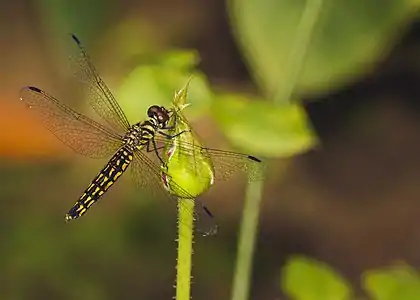Lyriothemis acigastra
Lyriothemis acigastra[2] or Little Bloodtail is a species of dragonfly in the family of Libellulidae known from India.[3][4] The International Union for Conservation of Nature also cites very old collections in Burma, China and Tibet.[1][5]
| Lyriothemis acigastra | |
|---|---|
 | |
| Male, Kadavoor | |
 | |
| Female, Kadavoor | |
| Scientific classification | |
| Domain: | Eukaryota |
| Kingdom: | Animalia |
| Phylum: | Arthropoda |
| Class: | Insecta |
| Order: | Odonata |
| Infraorder: | Anisoptera |
| Family: | Libellulidae |
| Genus: | Lyriothemis |
| Species: | L. acigastra |
| Binomial name | |
| Lyriothemis acigastra (Selys, 1878) | |
| Synonyms | |
|
Calothemis acigastra Selys, 1878 | |
The genus Lyriothemis is made up of 15 species and is widespread across Asia. Three species in the genus are known from India; L. cleis, L. tricolor and L. acigastra. All three were thought to be restricted to the northeastern states of Assam and West Bengal, but, in 2013, L. acigastra and L. tricolor were recorded in the southern state of Kerala.[3][6]
Description
It is a small dragonfly with brown-capped greenish-yellow eyes. Its thorax is blackish brown, marked with yellow. There is a broad oval antehumeral (situated in front of the fore legs)[7] stripe and a short transverse stripe bordering it just below. Laterally there are three stripes. The wings are transparent and palely tinted with yellow at the extreme base. The abdomen in the male is blood-red, tapered from base to end, and marked with black. Segment 1 is black, with its apical border narrowly red. Segment 2 has its base broadly black and apical borderless so. Segments 3 to 8 have the borders narrowly black and the mid-dorsal carina broadly so. This mid-dorsal black stripe dilates at the apical ends of 3 to 6. Segment 9 has only a narrow short red stripe on each side. Segment 10 is entirely black. The anal appendages are black.[5]
The female is similar to the male, except that the abdomen is cylindrical rather than tapered from base to end and is a reddish-yellow color instead of blood red.[5]
Habitat
Little is known about the species' ecology or habitat, which could be because of its rarity and secretive nature. The specimens reported in 2013 were found in bushes around freshwater marshland and streams. Individuals were generally at their most active in the evening and morning; males rested at around 8 to 10 metres (26 to 33 ft) from the ground, and preyed upon skippers and small moths.[3]
The species closely resembles the Sri Lankan species L. defonsekai, described in 2009.[8]
See also
References
- Dow, R.A. (2009). "Lyriothemis acigastra". IUCN Red List of Threatened Species. 2009: e.T163701A5638198. doi:10.2305/IUCN.UK.2009-2.RLTS.T163701A5638198.en. Retrieved 20 November 2021.
- Paulson, D.; Schorr, M.; Abbott, J.; Bota-Sierra, C.; Deliry, C.; Dijkstra, K.-D.; Lozano, F. (2023). "World Odonata List". OdonataCentral, University of Alabama. Retrieved 14 Mar 2023.
- Emiliyamma KG; Palot Md; Radhakrishnan C; Balakrishnan VC (2013). "Lyriothemis acigastra: a new addition to the odonata fauna of Peninsular India". Taprobanica: The Journal of Asian Biodiversity. 5 (1): 73–4. doi:10.4038/tapro.v5i1.5672.
- K.A., Subramanian; K.G., Emiliyamma; R., Babu; C., Radhakrishnan; S.S., Talmale (2018). Atlas of Odonata (Insecta) of the Western Ghats, India. Zoological Survey of India. pp. 334–335. ISBN 9788181714954.
- C FC Lt. Fraser (1936). The Fauna of British India, including Ceylon and Burma, Odonata Vol. III. Red Lion Court, Fleet Street, London: Taylor and Francis. pp. 265-267.
- Das, K.S.A.; K.A. Subramanian; K.G. Emiliyamma; M.J. Palot & K.A. Nishadh (2013). "Range extension and larval habitat of Lyriothemis tricolor Ris, 1919 (Odonata: Anisoptera: Libellulidae) from southern Western Ghats, India". Journal of Threatened Taxa. 5 (17): 5237–5346. doi:10.11609/JoTT.o3716.5237-46.
- "antehumeral — definition, examples, related words and more at Wordnik". Wordnik.com. Retrieved 2019-03-27.
- Poorten Nvd. "Lyriothemis defonsekai spec. nov. from Sri Lanka, with a review of the known species of the genus (Anisoptera: Libellulidae)". Odonatologica. 38 (1): 15–27.
